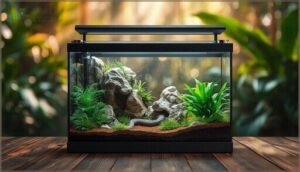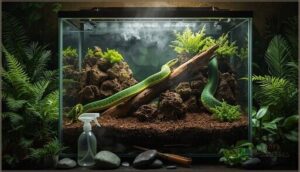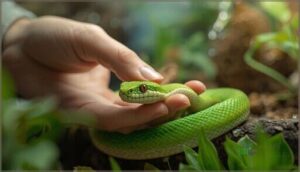This site is supported by our readers. We may earn a commission, at no cost to you, if you purchase through links.
Most reptile enthusiasts gravitate toward pythons or corn snakes, but grass snakes as pets offer something radically different—a species that swims, hunts amphibians, and carries that distinctive pale crescent behind its head like a badge of European wilderness.
These medium-sized serpents can stretch beyond five feet, demanding spacious vivariums with dual thermal zones and prey options that depart from the standard rodent routine. You’ll need to replicate wetland conditions, source frozen-thawed frogs, and commit to careful humidity control, yet the reward lies in observing behaviors that mirror their wild counterparts—behaviors most captive colubrids never display.
Table Of Contents
- Key Takeaways
- Choosing a Grass Snake as a Pet
- Setting Up The Ideal Grass Snake Enclosure
- Feeding and Nutrition for Grass Snakes
- Health, Behavior, and Handling
- Long-Term Care and Maintenance
- Frequently Asked Questions (FAQs)
- How Do I Know if My Grass Snake is Healthy?
- Are There Any Special Considerations When Handling Grass Snakes?
- How Often Should I Feed My Grass Snake?
- What Substrates Are Suitable for the Enclosure of a Grass Snake?
- Can a grass snake be kept as a pet?
- What do you feed grass snakes?
- Can a grass snake hurt a human?
- Can you keep green snakes as pets?
- Are pet garter snakes friendly?
- Can I keep a garden snake as a pet?
- Conclusion
Key Takeaways
- Grass snakes demand spacious vivariums with dual thermal zones (85–90°F basking, 70–75°F cool), 40–60% humidity control, and specialized diets of frozen-thawed amphibians rather than standard rodents, making them unsuitable for beginners but rewarding for intermediate keepers seeking semi-aquatic behaviors.
- Proper enclosure setup requires at least 3–4 times the snake’s body length in horizontal space, moisture-retaining substrates like coconut fiber or cypress mulch at 2–4 inches depth, and multiple climbing structures with hiding spots to replicate their natural wetland environment.
- Feeding protocols center on appropriately sized frozen-thawed frogs every 7–14 days for juveniles and 10–14 days for adults, with mandatory 24–48 hour handling restrictions post-feeding to prevent regurgitation and digestive complications.
- Long-term commitment spans 15–20 years with daily temperature and humidity monitoring, weekly substrate replacement, monthly weight tracking, and vigilance for respiratory infections or shedding problems that signal environmental parameter failures.
Choosing a Grass Snake as a Pet
Grass snakes aren’t your typical beginner pet, and that’s exactly what makes them appealing to keepers who want something different. These medium-sized European natives bring unique challenges and rewards compared to the corn snakes and ball pythons you’ll find in every pet store.
Before you commit to one, you need to understand what sets them apart regarding size, temperament, and where to actually find a healthy captive-bred specimen.
Size, Lifespan, and Physical Traits
You’ll find that grass snakes can reach impressive lengths of up to 180cm, making them medium-sized captives demanding thoughtful reptile husbandry. Their body shape features a distinctive light-colored crescent collar behind the head, with scale texture varying from smooth to slightly keeled depending on regional genetics.
Color patterns typically display olive-brown dorsally with lighter ventral surfaces, and their growth rate depends heavily on consistent snake care, proper diet, and ideal environmental parameters.
To guarantee proper care, understanding the snake care basics is essential for maintaining a healthy pet.
Grass Snake Vs. Other Pet Snakes
Grass snakes stand apart in any pet snake comparison due to their diurnal nature and higher daytime activity, unlike nocturnal ball pythons that dominate reptile husbandry circles. Their moderate humidity needs (40–60%) simplify snake habitat maintenance compared to tropical species, while their non-venomous profile and straightforward dietary requirements make snake care accessible.
However, captive-bred availability lags behind corn snakes, demanding careful breeder selection for ethical reptile community engagement. When writing about grass snakes, it’s vital to use clear science writing to effectively communicate their needs and characteristics.
Where to Find Captive-Bred Grass Snakes
Locating captive-bred specimens requires diligence, as reptile breeders and licensed pet stores rarely stock grass snakes in abundance compared to mainstream species.
Online marketplaces demand credential verification to avoid wild-caught animals, while herpetological societies maintain vendor recommendations for ethical exotic pet care and management.
Wildlife departments may require permits, ensuring your reptile husbandry and breeding practices align with regional regulations governing snake breeding and reptile care standards.
Setting Up The Ideal Grass Snake Enclosure
Your grass snake’s enclosure isn’t just a container—it’s the foundation of their health, behavior, and longevity in captivity. Getting the setup right from the start means understanding the specific environmental parameters these snakes require, from thermal gradients to humidity levels, and selecting materials that support their natural behaviors.
Your grass snake’s enclosure isn’t just a container—it’s the foundation of their health, behavior, and longevity in captivity
The following sections break down each critical component you’ll need to create a proper habitat that keeps your grass snake thriving.
Recommended Tank Size and Type
Your snake deserves more than a cramped box—it needs a fortress it can’t outsmart. A 20-gallon glass terrarium works for juveniles up to 3 feet, while adults require larger vivariums with secure latching lids to prevent escapes. Tank dimensions should provide at least 3–4 times the snake’s body length in linear space, with screened ventilation systems promoting airflow without drafts.
- Horizontal enclosures accommodate their active, ground-dwelling hunting style
- Dual-zone setups enable natural thermoregulatory behaviors
- Escape-proof locks protect your investment and your sanity
Temperature, Humidity, and Lighting Needs
Without proper thermal gradients, your grass snake can’t digest food or regulate stress—making temperature control non-negotiable. You’ll need a basking lamp or heat mat to create a warm zone (85–90°F) and a cooler retreat (70–75°F), with nighttime drops to 65–75°F supporting natural cycles.
Humidity control between 40–60% prevents respiratory issues, while UVB light and 12-hour lighting cycles improve health. Environmental monitoring with dual thermometers and hygrometers ensures temperature fluctuations stay minimal, and your heat source never overheats basking zones.
| Parameter | Target Range |
|---|---|
| Basking Zone | 85–90°F |
| Cool Zone | 70–75°F |
| Night Temp | 65–75°F |
| Humidity | 40–60% |
Substrate and Safe Decorations
For proper humidity control and reptile habitat and environment safety, you’ll need a substrate that retains moisture without promoting mold, such as coconut fiber or cypress mulch at 2–4 inches depth for natural burrowing.
Vivarium decorations must be non-toxic, securely anchored, and free of sharp edges, while live plants and rough-textured cork bark provide snake enrichment.
Tank maintenance includes:
- Spot-cleaning substrate daily to reduce ammonia buildup
- Full substrate replacement every 1–3 months
- Inspecting decor for wear that risks ingestion
- Using reptile-safe disinfectants on terrarium design and management surfaces
Providing Climbing and Hiding Spots
You’ll need at least 2–3 vertical climbing structures—rough cork bark, rope twists, and sloped branches—to mimic arboreal features in your vivarium. Texture variety on climbing surfaces lets your snake grip naturally.
Multiple hiding places at different heights reduce stress during active periods. Careful terrarium design and management with separate zones for retreat ensures proper reptile habitat and environment safety without crowding the vertical space.
Feeding and Nutrition for Grass Snakes
Grass snakes are carnivorous reptiles that thrive on a straightforward diet of whole prey items, which means you won’t need to worry about complicated meal preparations or hunting down exotic food sources.
Your snake’s nutritional needs revolve around providing appropriately sized frozen-thawed prey on a consistent schedule, along with fresh water and occasional supplementation to support peak health.
Understanding what to feed, how often to feed, and how to guarantee proper hydration will keep your grass snake in prime condition throughout its life.
Appropriate Diet and Prey Options
Your grass snake’s carnivorous nature demands a diet rooted in what evolution designed them to hunt. In the wild, these sleek predators target amphibians like frogs and tadpoles, which should guide your prey selection in captivity.
Dietary requirements center on appropriate frozen-thawed foods to ensure nutrient balance and safety:
- Thawed frozen frogs from reputable suppliers offer species-appropriate nutrition without parasite risks
- Gut loading prey with nutrient-rich diets enhances micromineral and vitamin intake for your snake
- Rodents can substitute when amphibian prey isn’t available, though they’re not the natural choice
Always match prey size to your snake’s girth—roughly one-half to two-thirds the mid-body diameter—to prevent regurgitation and support healthy digestion. Dietary supplements aren’t usually routine; rely on well-prepared, gut-loaded prey and consult an exotic animal vet for customized feeding techniques. Don’t force-feed, and remember that fresh food and water access remains essential beyond prey offerings alone.
Feeding Schedule and Techniques
Timing your prey offerings correctly unlocks healthier growth and fewer feeding problems. Juveniles thrive on meals every 7 to 14 days, while adults can stretch to 10 to 14-day intervals based on body condition and appetite.
Use tongs to present warm, thawed prey at a designated feeding station, reducing substrate ingestion and defensive strikes. Always wait 24 to 48 hours before handling to support complete digestion.
| Life Stage | Feeding Frequency |
|---|---|
| Juvenile | Every 7–14 days |
| Adult | Every 10–14 days |
| Post-feeding rest | 24–48 hours before handling |
Supplements and Gut-Loading Prey
You can’t just toss frozen-thawed foods at your grass snake and call it a day—prey nutrition matters. Gut-loading mice with calcium-rich diets 24 to 48 hours before feeding ensures your snake absorbs essential nutrients.
Vitamin D3 remains controversial among breeders, so monitor calcium:phosphorus ratios closely. Balanced prey nutrition prevents metabolic bone disease in insectivores and carnivores alike, giving your pet the nutrient balance it demands.
Water Requirements and Hydration
Beyond feeding frozen prey, your grass snake demands constant access to clean, fresh water—this isn’t negotiable. A shallow dish large enough for body immersion facilitates drinking behavior and aids shedding, especially when humidity levels hover around 40 to 60 percent.
Watch for hydration signs like clear eyes and elastic skin; sunken eyes or wrinkled texture signal trouble in your reptile housing and environment setup.
Health, Behavior, and Handling
Keeping your grass snake healthy means knowing what to watch for, how to handle them without causing stress, and staying on top of routine maintenance like shedding and tank hygiene.
These snakes are hardy when their needs are met, but they’re also excellent at hiding early signs of trouble.
Here’s what you need to monitor and manage to keep your snake thriving for years to come.
Common Health Issues and Prevention
Vigilance forms your first line of defense against common ailments in captive grass snakes. Respiratory infections emerge when cold, damp conditions combine with poor ventilation, while intestinal parasites infiltrate through contaminated water or inadequate prey. Shedding problems signal insufficient humidity, and metabolic disease stems from improper temperatures.
You’ll need prompt veterinary care for mouth rot following stress or injury, making preventive pet snake care and maintenance essential for health and hygiene.
Recognizing Signs of Stress and Illness
Detecting stress symptoms early saves your grass snake from spiraling into serious illness. You’ll notice behavioral shifts before physical health monitoring reveals disease—watch for appetite loss lasting beyond two weeks, prolonged hiding, or respiratory distress signaling veterinary care needs.
- Refusal to eat disrupts snake feeding and nutrition patterns you’ve established
- Lethargy during handling exposes declining green snake behavior and health
- Abnormal breathing demands immediate attention for health and hygiene
Safe Handling and Socialization Tips
Once you’ve spotted stress signals, proper snake handling becomes your next priority. Wait at least 24 hours after feeding before lifting your grass snake to prevent regurgitation—use one hand supporting the midsection, the other guiding the tail in gentle restraint.
Limit sessions to a few minutes weekly in calm environments, watching for rapid tongue-flicking or frantic escape attempts that signal stress reduction needs through reptile behavior and socialization adjustments.
Shedding, Hygiene, and Routine Care
Your grass snake’s shedding cycle demands attention—juveniles shed every 4–6 weeks, adults every 6–12 weeks, with humidity control at 60% easing skin health during these transitions.
Enclosure cleaning and hygiene practices form your reptile husbandry foundation:
- Replace substrate every 1–3 months to prevent bacterial growth and odors
- Provide fresh water daily, sanitizing bowls between uses for superior pet care
- Spot-clean feces and shed fragments immediately using reptile-safe disinfectants
- Inspect your snake during routine checks for retained eye caps or partial sheds
- Maintain consistent temperature gradients supporting normal snake care and maintenance
Daily habitat creation vigilance prevents most shedding problems before they escalate.
Long-Term Care and Maintenance
Keeping a grass snake healthy for years means staying consistent with the basics—cleaning, feeding, and watching for changes that signal trouble. You’ll need to develop a rhythm that balances daily checks with deeper weekly tasks, all while tracking how your snake grows and reacts to its environment.
Once you’ve got the routine down, you’ll be better equipped to spot problems early and decide whether a grass snake truly fits your lifestyle.
Daily and Weekly Husbandry Tasks
Keeping your snake thriving means sticking to a rhythm of reptile husbandry that won’t let you slack—temperature monitoring, humidity control, and enclosure cleaning form the backbone of daily pet care. You’ll check the thermal gradient every morning, refresh water, and spot-clean waste to maintain snake hygiene, while weekly tasks demand full substrate replacement, disinfection of habitat creation elements, and verification of feeding schedules.
Here’s your animal husbandry breakdown for snake care and maintenance:
| Task Frequency | Critical Action |
|---|---|
| Daily | Inspect temperature gradient (28–32°C warm, 22–26°C cool) |
| Daily | Check humidity (40–60%), clean water bowl, remove waste |
| Daily | Verify 12–14 hour lighting cycle |
| Weekly | Perform thorough enclosure cleaning with substrate refresh |
| Weekly | Inspect enclosure seals, ventilation, measure parameters at multiple points |
Monitoring Growth and Wellbeing
You’ll track wellness through consistent weight tracking and environmental monitoring, catching subtle shifts in growth rates before they escalate into major health issues. Regular health checks reveal how thermoregulation, animal behavior, and nutritional balance intersect, giving you real control over your snake’s trajectory in reptile keeping and husbandry.
- Weigh your snake monthly to document growth rates and detect weight loss early
- Record feeding response times as behavioral indicators of overall wellness
- Log environmental monitoring data alongside health checks to identify patterns
- Inspect skin condition during handling to spot respiratory infections or parasites
- Maintain a husbandry journal tracking snake diet and nutrition against physical changes
Troubleshooting Common Care Challenges
When feeding difficulties emerge, you’ll adjust prey size and presentation technique, recognizing that animal behavior shifts signal thermoregulation problems or environmental enrichment gaps in grass snake care and maintenance.
Respiratory issues demand immediate humidity control intervention, while shedding problems trace back to hydration deficiencies in snake diet and nutrition protocols.
Master these corrections, and you’ll command every aspect of reptile keeping and husbandry with precision.
Commitment and Suitability as a Pet
You’re committing 15 to 20 years to exotic pets that demand specialized reptile husbandry, consistent snake care routines, and financial investment in long-term costs, including veterinary services and equipment.
Pet responsibility extends beyond daily tasks—snake behavior and family dynamics must align with your pet owner lifestyle, as grass snakes require minimal handling and stable environments.
Herpetology knowledge and dedication to animal care and husbandry separate successful keepers from those who underestimate this commitment.
Frequently Asked Questions (FAQs)
How Do I Know if My Grass Snake is Healthy?
A healthy grass snake is like a well-tuned instrument. Smooth scales, bright eyes, steady appetite, and active behavior signal wellness, while respiratory health, hydration cues, and regular veterinary care complete the picture.
Are There Any Special Considerations When Handling Grass Snakes?
You’ll want to support the entire body with both hands, avoiding neck pinches or tail grabs.
Wash hands before and after handling to prevent bacterial transfer, and watch for stress signals like rapid tongue flicking.
How Often Should I Feed My Grass Snake?
You should offer appropriately sized prey every 5–7 days for juveniles and every 7–14 days for adults.
Adjust feeding frequency based on growth monitoring, body condition, and individual appetite rather than rigid schedules.
What Substrates Are Suitable for the Enclosure of a Grass Snake?
Picture a snake gliding across a surface that feels wrong—too sharp, too wet, too sterile. Your substrate choice shapes every moment your grass snake spends in its vivarium, affecting humidity control, enclosure hygiene, and snake enrichment simultaneously.
Reptile carpet or coconut husk fiber both work well, offering substrate safety while maintaining proper substrate depth for natural habitat behaviors and easy snake care maintenance.
Can a grass snake be kept as a pet?
Yes, grass snakes can be kept as pets under proper reptile ethics and exotic pet ownership regulations, but captive breeding programs and understanding snake behavior are essential before committing to vivarium habitat maintenance and specialized snake care requirements.
What do you feed grass snakes?
Grass snakes thrive on a carnivorous diet of frozen-thawed amphibians, particularly frogs and toads. Prey selection is matched to their size, ensuring a balanced approach to snake care and nutrient balance.
Feeding techniques involve using tongs, and meals are provided once weekly to maintain optimal health.
Can a grass snake hurt a human?
Unlike their venomous cousins, these non-threatening reptiles pose minimal snake bite risks to human safety.
Though defensive behavior may prompt a harmless nip, basic injury prevention and proper animal behavior understanding are essential for wildlife conservation.
Can you keep green snakes as pets?
You can keep green snakes—both rough green snake and smooth green snake species—as pets, though reptile husbandry requires understanding care sheet specifics, green snake handling techniques, reptile laws, snake escape prevention, and pet insurance options for best reptile care.
Are pet garter snakes friendly?
When approached calmly and handled consistently, most captive-bred garter snakes tolerate gentle interaction. However, individual temperament varies—some remain skittish, while others show striking ease with routine care and minimal stress responses.
Can I keep a garden snake as a pet?
You can technically keep a garden snake as a pet, but verify local Pet Snake Laws first—wild-caught reptiles often carry stress, parasites, and struggle adjusting to vivarium life, making captive-bred Grass Snake specimens far healthier choices.
Conclusion
Grass snakes as pets won’t fit every keeper’s blueprint, but if you’re prepared to source amphibian prey, maintain precise humidity gradients, and dedicate square footage to a swimmer that defies the typical colubrid mold, you’ll reveal behaviors most captive serpents never express.
This isn’t a beginner’s first purchase, yet for intermediate enthusiasts craving European authenticity and semi-aquatic activity, the pale-collared hunter delivers an experience worth every logistical hurdle.














